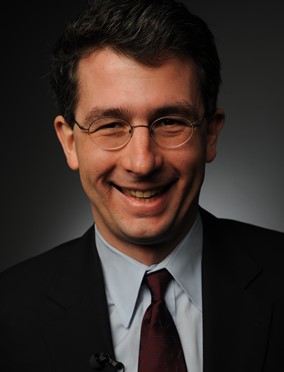Martin van der Meij of the Telegraaf Media Groep -- The Jay Sears Interview

Continuing a recent series of interviews with global trading desk heads that culminated in his Six Advertising Automation Trends for Buyers and Sellers, Jay Sears, SVP at Rubicon Project, now hears from the sell side—leading publishers across the United States and Europe.
Today he speaks with the Netherlands’ Telegraaf Media Groep.
Your Name: Martin van der Meij
Your Company: Telegraaf Media Groep
Your Title: Head of Revenue Development
What Flavor Ice Cream Best Describes Your Management Style:
Chunky monkey
SEARS: On average—out of each $1.00 of advertising revenue received by your company, how much today is from automated or programmatic channels?
VAN DER MEIJ: $0.50 is automated right now. This includes display, mobile and video. For 2014, the outlook will be close to $0.60 and we also will start with automation of digital radio.
SEARS: What was this number two years ago, in 2011?
VAN DER MEIJ: Roughly $0.35
SEARS: What will this number be two years from now, in 2015?
VAN DER MEIJ: We did some internal research a few years back and we think the top could be around $0.75.
SEARS: Describe how most media (all media, digital + non-digital, non-programmatic media) is sold by your company today.
VAN DER MEIJ: For non-digital it is being sold very traditionally with a direct sales force focus on several industries and the agencies. For digital we have automated already a lot. For 2014, we will start looking at the automation of print/radio also.
Our whole technology stack is being transformed into a LEGO approach, meaning we can replace parts whenever needed. We expect technology changes for the next few years within the whole company and for all sales (print/radio/online).
SEARS: Tell us the about Telegraaf Media Groep (TMG).
VAN DER MEIJ: TMG is a traditional news publisher. For some reason it seems we jumped on the automated wagon quite early. At this moment we take advantage of this situation and we’re focusing on automation big time. We just think that we need more publishers to join us to gain enough scale to win this battle.
Automation for us is about lowering the cost of operation on the B2B side. This way we want to prevent as much cost savings on the content side so we can keep the quality of our content at the level we prefer.
PLEASE TELL US:
· Percentage increase, advertising revenue via automated systems 2012 vs. expected 2013 [Global only #]:
o VAN DER MEIJ: Roughly 50%
· How many employees do you have globally [headcount number]?
o VAN DER MEIJ: 1500 FTE just in the Netherlands
SEARS: What are TMG’s three biggest initiatives for 2014?
VAN DER MEIJ:
1. Publisher Market: New division that will help other publishers across Europe with their automated trading strategy.
2. E-Commerce: We will focus harder and more on our B2C revenue streams.
3. Video: We move more and more into a media house. Online/Print/Radio are there. Video is next.
SEARS: By 2015, what percentage of total advertising sales across your company will be from automated or programmatic channel?
VAN DER MEIJ: Hard to say because we don’t know exactly how fast the market can move. But we’re aiming at 50%+. This includes the automation or yield management approach for print.
SEARS: To reach a higher adoption of direct deal automation (also known as programmatic premium) and use of the programmatic channel, what are the major impediments to overcome?
VAN DER MEIJ: Most publishers and agencies in the Netherlands do understand the true power of automated trading. The biggest problem is technology. Simple things such as expandables or roadblocks are not possible to automate at this point.
SEARS: Tell us about your first party data strategy—do you currently have a DMP (data management platform) for your first party data?
VAN DER MEIJ: We do have a DMP (Audience Science) but we’re not using it to its full potential. The lack of good intent data within our holding group is a challenge. For 2014 we’re working on a solution to get more intent data into our DPM. The other challenge is how can we sell/report on this data? It seems the technology is not there where we want it to be. So this could lead in developing (or co-developing) the technology we need.
SEARS: Salesforce compensation. Do you compensate your salespeople for every dollar [or local currency equivalent] sold, regardless if the media is sold via insertion order (IO) manually or via an automated channel?
VAN DER MEIJ: Our salespeople are compensated on every dollar sold -- manual, direct order automation [(Rubicon Project) Connect] and auction. Salespeople have a responsibility at an advertiser level. This means we don’t care how they spend their money as long as they spend budgets with us. To prevent a huge channel conflict we compensate our salespeople at the moment for revenue that’s coming thru the automated channel.
SEARS: Direct sold inventory is often sold three to 12 months in advance. Which of the following choices best describe how you use direct order automation and Connect?
VAN DER MEIJ: We use direct order automation and Connect to make available IAB Rising Star ad units and rich media ad units. For standard IAB the auction works out fine. I think it’s fair to expect the end of rate cards for those ad sizes. This means we focus with direct automation on the less traditional sizes. But as I said, this is a huge challenge because the technology worldwide seems to have a problem to catch up.
SEARS: What advertising opportunities will never be sold via advertising automation?
VAN DER MEIJ: Content intergrations. We can automate advertorials to some level. But as soon as we go into the actual content integrations and partnerships (reiskrantreporter we created for KLM as an example). This stuff can never be automated.
SEARS: Have you received “Programmatic RFPs” for your inventory? What do these look like and how are they different than traditional RFPs?
VAN DER MEIJ: We’re not using Programmatic RFPs.
SEARS: What should top publisher chief revenue officers (CROs) do to build their direct order automation (also known as programmatic premium) and programmatic selling business with trading desks and operating agencies?
VAN DER MEIJ: Most publishers focus too much on technology or on the difference between auction based and deal IDs. The conversation the CRO should be having is “how can I maximize my revenue?” That’s much simpler. We still think that the airline industry is the best example. You have a certain amount of goods to sell (advertising space/seats) and you want to maximize the revenue per day/flight. This means price differentiation is crucial. Because of the amount of advertising space we can’t do this manually. That’s why we automate.
SEARS: Why is direct deal automation (also known as programmatic premium) so important? Is it important?
VAN DER MEIJ: Direct deal automation is not a goal. It’s just something we need to make sure we optimize everything (see above).
SEARS: What global markets are the leaders and laggards in programmatic?
VAN DER MEIJ: According to other people the Dutch market is the most advanced market at the moment. Knowing what we have in mind for 2014 I think it’s fair to assume that situation won’t change. Other leading markets are the UK and US. But that’s more of a scale situation than from an innovation point of view.
Tell us a bit more about you:
SEARS: If you could travel for pleasure anywhere in the world, to a place you have never been, where would you go?
VAN DER MEIJ: I would probably rent a mobile home and tour across the US for a few months.
SEARS: If you were trapped alone on a desert island and needed to choose one ad holding company CEO to accompany you, which CEO would you pick and why?
VAN DER MEIJ: I think it’s a culture thing. So for that reason I won’t pick one of the obvious US companies. I would probably go for Marco Kloots (CEO of Platform161). We are close since 2009 so there is a fair chance we both are still alive after a few weeks -- ha ha ha.
SEARS: When was the last time you went out for a three martini lunch?
VAN DER MEIJ: I don’t do martini lunches. Never did.
Thanks Martin!
Jay Sears is Senior Vice President, Marketplace Development for the Rubicon Project. Sears works with leadership and business unit heads across the company to expand Rubicon Project’s potential market. Sears has also served as General Manager, REVV Buyer, where he was responsible for global relations with the buy side including ad holding companies, ad agencies, agency trading desks and demand side platforms headquartered in North America. Jay can be reached at jsears@rubiconproject.com.
with leadership and business unit heads across the company to expand Rubicon Project’s potential market. Sears has also served as General Manager, REVV Buyer, where he was responsible for global relations with the buy side including ad holding companies, ad agencies, agency trading desks and demand side platforms headquartered in North America. Jay can be reached at jsears@rubiconproject.com.
Check us out on Facebook at MediaBizBloggers.com
Follow our Twitter updates at @MediaBizBlogger
The opinions and points of view expressed in this commentary are exclusively the views of the author and do not necessarily represent the views of MediaBizBloggers.com management or associated bloggers. MediaBizBloggers is an open thought leadership platform and readers may share their comments and opinions in response to all commentaries.


